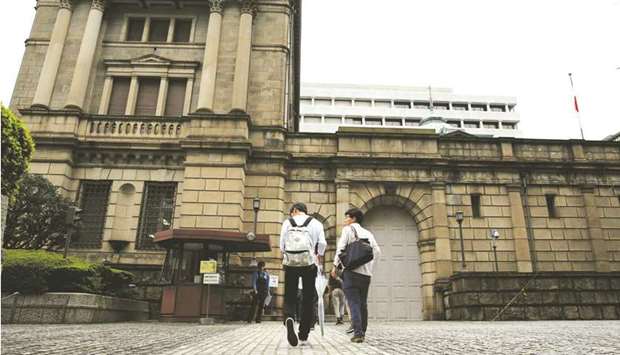Central bankers from Washington to Tokyo will this week confront the enthusiasm of investors betting on a return of inflation, delivering policy responses ranging from cautious tolerance to interest-rate increases.
For many such officials, the three-day frenzy of meetings starting on Wednesday is the first scheduled opportunity to act since a global rout in government debt markets took hold in February, fuelled by speculation of a pickup in prices after the coronavirus crisis abates.
The US Federal Reserve’s decision will be the most significant among at least 11 monetary announcements due around the world. Chairman Jerome Powell is likely to affirm a loose stance that stops short of the heightened activism of the European Central Bank, which last week pledged to frontload bond purchases.
The Bank of England might take a view similar to the Fed’s as it focuses on growth risks still dominating the outlook. The Bank of Japan will unveil a policy review, possibly tweaking stimulus programs and even maybe reiterating its capacity to cut rates further.
Other monetary authorities are likely to be less sanguine. Central banks in Norway and Russia may signal shifts to a more hawkish stance, while officials Brazil and Turkey could deliver the Group of 20’s first rate hikes of 2021.
“Central banks went into the Covid crisis together. They will exit separately. For the Fed and Bank of England, slightly higher yields can be tolerated as an early sign of recovery. For Brazil, they contribute to a more challenging environment that’s likely to force a rate hike -- despite a raging virus and risks to growth”, says Tom Orlik, chief economist at Bloomberg.
Elsewhere, ECB President Christine Lagarde speaks to European Union lawmakers and China gets its first set of hard data this year.
US and Canada: The Federal Open Market Committee, holding its second meeting of the year March 16-17, is almost certain to keep interest rates near zero and pledge to continue its asset purchases at the current pace. Wall Street economists’ focus will be on the central bank’s quarterly forecasts, including whether the panel includes an initial rate hike in the 2023 projections, in response to a pickup in the outlook for growth.
A strong recovery from the Covid-19 recession is likely to prompt Fed Chair Jerome Powell and his colleagues to lift interest rates in 2023, but that isn’t going to show up in their forecasts this week, a survey showed.
In terms of upcoming economic data, investors will be watching for the latest reading on retail sales, industrial production, housing starts and weekly jobless claims to gauge the strength of the recovery as more states drop restrictions on activity and vaccines are deployed more widely.
Europe, Middle East, Africa: Aside from the BoE decision, investors watching the UK may take notice of changes to the list statisticians use to gauge living costs on Monday, with pandemic-related changes to Britons’ lifestyle expected to be reflected in the updated basket of goods and services.
ECB President Lagarde will speak to EU lawmakers in Brussels on Thursday, a week after her institution pledged to ramp up buying government debt in coming months in a bid to a contain rising bond yields that threaten to derail the euro area’s economic recovery.
The week also sees a flurry of rate decisions elsewhere across the region, with central banks in the Norway and Egypt expected to stay on hold.
The Bank of Russia is also forecast to keep its monetary settings unchanged, but officials are pivoting from a string of cuts aimed at stimulating the economy through the pandemic last year to a tightening stance as inflation surges. That concern is likely to prompt Turkish monetary officials to hike rates to try to rein in inflation.
In Africa, Mozambique’s central bank may keep rates unchanged after the country’s currency, the metical, stabilised following a surprise 300 basis-point hike in January.
Asia: Economic activity data due on Monday for the first two months of the year will show roaring growth in China, with figures largely distorted by comparisons from a year ago when the economy was in lockdown. Complicating the picture further are the travel restrictions imposed ahead of the Lunar New Year break in February, which curbed consumption but allowed factories to resume production earlier than usual.
The BoJ is expected to unveil an array of tweaks to its policy framework while keeping its main settings on hold following a review of its measures on Friday. There will be plenty for markets to digest as the central bank looks to freshen up its control of rates and asset purchases while shoring up stimulus for the longer term.
Inflation data out the same day is likely to show prices are still falling almost eight years after the BoJ launched its massive stimulus program.
Indonesia and Taiwan have interest rate decisions on Thursday.
Latin America: Brazil’s economic activity indicator for January out Monday may show that the country’s modest recovery is stalling, while Peru’s gross domestic product proxy for the same month may post a second straight year-on-year rise even with joblessness stuck around 13%. Colombian data on industrial output, retail sales and economic activity for January will likely reflect renewed lockdown measures amid weak domestic demand.
Brazil’s central bank on Wednesday is all but certain to tighten policy for the first time since 2015 and raise its key rate by a half-point to 2.5%. Given the recent surge in inflation, Wednesday’s increase probably won’t be the last.
On Thursday, Chile posts fourth-quarter and full year output data.
Hefty monetary and fiscal stimulus, surging demand for copper, which accounts for about half of the country’s exports, and one of the world’s best vaccine rollouts have pushed some 2021 GDP estimates over 6%.

Men walk towards the Bank of Japan building in Tokyo. The BoJ is expected to unveil an array of tweaks to its policy framework while keeping its main settings on hold following a review of its measures this week.


